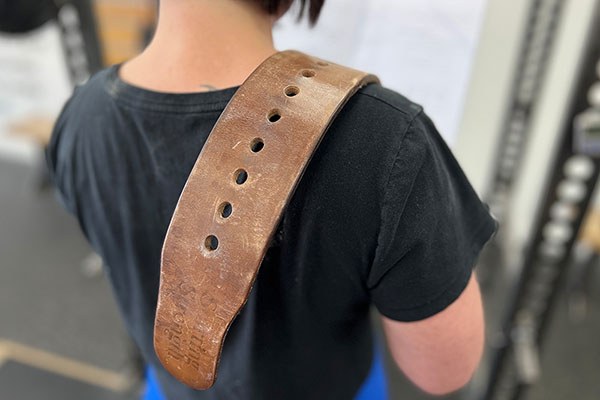
The Belt and Your Training
by Mark Rippetoe | October 14, 2024
The function of the belt was
detailed in a previous article on this website. Used properly, it reinforces
the stiffness of the spine under a load. And to the extent that all
the lifts depend on force transfer through the spine, the belt helps
with efficiency in the lift while protecting the spine from wiggling
around under compression.
Here
are a few random thoughts about the belt and the lifts. Feel free to
add to it in the comments.
Most
people associate the belt with the deadlift and the squat, and it
certainly benefits these two movements by producing a hoop-tension
reinforcement around the spine over and above what the abdominal
musculature can provide. But the truth is that the press benefits
more from the belt than any of the other barbell lifts. The bench
benefits too, but this requires some experience with the set-up and
the timing. A shitty flexible belt works just fine for the bench
press – it’s not supporting your compressively loaded spine
anyway, and it’s easier to tighten while sitting on the bench (if you
don’t use the rack uprights).
The
Olympic lifts benefit as well, but the buckle can get in the way of
an efficient, close pull, and most lifters will turn the belt around
so that the buckle is on the low back, or use a Velcro belt that
doesn’t get in the way of the pull. The first time you catch the bar
under the buckle in a pull will be a memorable experience, and you
will alter your behavior accordingly.
As
mention in the linked article, a 3-inch belt works far better for
most people than a 4-inch, unless you are unusually long-waisted. I
prefer a smooth-leather belt, because it slides into tightness easier
than a nappy suede belt, but this is largely a matter of personal
preference. The suede is usually a thin piece of leather veneer, that
will eventually wear out before the rest of the belt, but some people
like the way suede grips the shirt. I think the primary effect of the
belt comes from the compression of the hoop tension, not the “grab.”
So our two-ply smooth leather Starting Strength belt from Dominion
Strength Training is always my recommendation for people wanting to
upgrade.
Don’t
get a cheap shitty belt to save money. A cheap buckle without a solid
roller will not last as long as the leather. A cheap buckle with a
skinny pin can actually cut through the belt, especially if the
leather is cheap or thin. This problem is solved with a 2-pin buckle,
with only half the force applied to each hole in the belt. But a good
belt with decent leather and correctly punched holes will not suffer
this fate. And two pins are harder to manage if you’re in a hurry to
get your belt on.
You
should not have to buy a belt more than once, because a good one will
not wear out or break. Your belt and your lifting shoes are the most
important pieces of your training equipment, so invest in quality and
take care of them. Lift in junk only for as long as it takes to save
up for good equipment, and you don’t have to buy it all at once.
You’ll be surprised at the difference it makes under the bar.
There
is a reason to have a single-ply belt: they are more flexible across
their width than a double ply, making it conform to the shape of your
waist better than a stiffer belt. This problem is largely solved by
the 3-inch width, and is probably a moot point in 2024, with modern
access to the latest developments in 3-inch belt technology. But I
promised random thoughts.
I
am always puzzled when I see a lifter finish a set and immediately
take the belt off and throw it on the platform, like they’re spiking
the ball. Why do this? It’s now a trip hazard on the floor, and you
just have to pick it up to put it back on. Why not just loosen it and
wear the damn thing between sets, to keep your back warm? I put the
belt on at 135, loosely, and make it tighter as the weight increases.
The first time you hurt your back – and you will, eventually,
everybody does – every loaded set thereafter should be belted. I
take it off after the last set.
Learn
to use the rack uprights to tighten the belt. Bend the tongue around
the upright C-channel and lean back to pull the belt through the
roller buckle until it’s as tight as it needs to be. Avoid wearing it
so tight that you cannot set your abs after your valsalva – this is
certainly possible with one hole too far. If in doubt, wear it one
hole looser rather than one hole too tight.
This
is all I could think of on short notice. Feel free to add your own
wisdom to the discussion in the comments.
Discuss in Forums
Credit : Source Post






